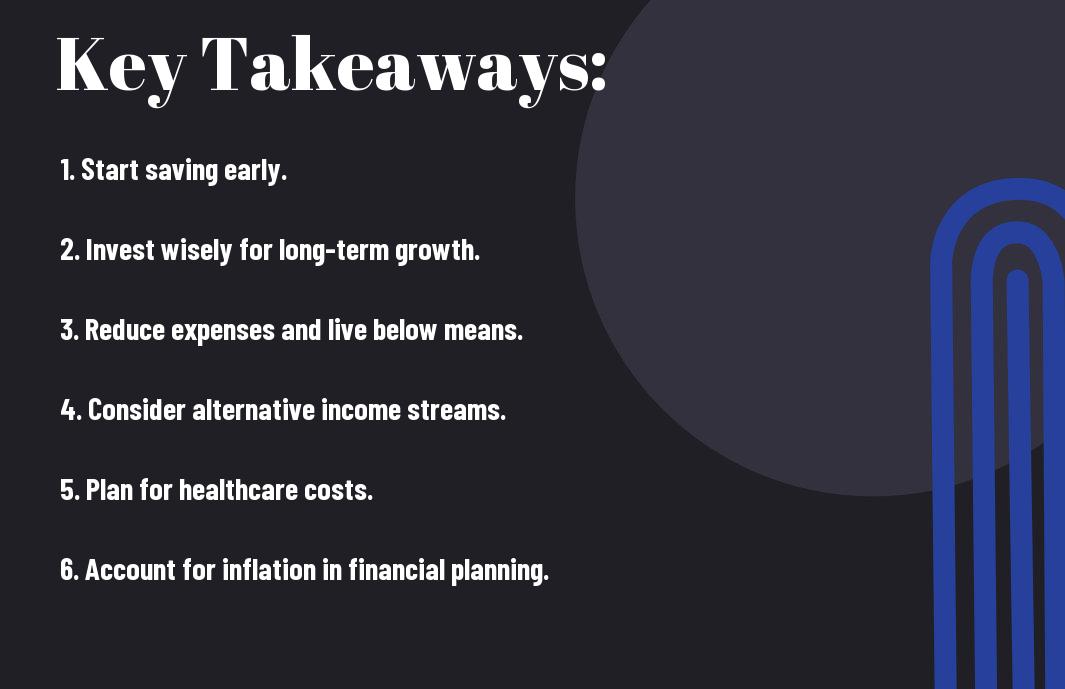It’s a dream that many individuals aspire to achieve – early retirement. The idea of saying goodbye to the nine-to-five grind and embracing a life of leisure sooner rather than later is certainly enticing. However, making early retirement a reality requires careful planning, strategic financial decisions, and lifestyle adjustments. In this blog post, we will explore key strategies and considerations for those looking to expedite their retirement timeline and achieve financial independence at a younger age.
Key Takeaways:
- Start saving and investing early: Begin contributing to retirement accounts as soon as possible to maximize compound interest and grow your savings over time.
- Develop a detailed financial plan: Calculate your retirement expenses, estimate your retirement income sources, and create a budget to track your progress towards early retirement goals.
- Consider lifestyle adjustments: Evaluate your current spending habits and identify areas where you can cut back to increase your savings rate. This may involve downsizing your home, reducing unnecessary expenses, or finding ways to increase your income.
- Explore passive income opportunities: Look for ways to generate passive income streams, such as rental properties, dividend-paying investments, or online businesses, to supplement your retirement income and support your early retirement lifestyle.
- Seek professional guidance: Consult with a financial advisor or retirement planner to review your financial plan, identify potential risks, and adjust your strategy as needed to achieve your early retirement goals.

Assessing Your Current Financial Situation
Even before setting out on the path to early retirement, it is crucial to assess your current financial standing. This involves a thorough evaluation of your income sources and expenses, as well as understanding your net worth and cash flow. By gaining a clear picture of where you stand financially, you can better chart a course towards achieving your retirement goals.
Evaluating Income and Expenses
Income plays a vital role in determining your ability to save for retirement. Calculate your total monthly income from all sources, including salary, investments, and any other earnings. On the other hand, expenses must be closely monitored to identify areas where costs can be reduced or eliminated altogether. This analysis will help you determine how much you can realistically save towards early retirement.
Understanding Net Worth and Cash Flow
Assessing your net worth involves calculating the difference between your assets and liabilities. This provides a comprehensive view of your financial health and helps in making informed decisions about retirement planning. Cash flow analysis, on the other hand, helps you understand how money moves in and out of your accounts, giving insight into your spending habits and potential areas for improvement.
The Role of Debt in Early Retirement Planning
Role debt can significantly impact your ability to retire early. High levels of debt, especially high-interest debt, can eat into your savings and delay your retirement timeline. It is necessary to prioritize paying off debt to reduce financial burdens in retirement. For instance, creating a debt repayment plan can help accelerate your journey towards financial freedom and early retirement.
Setting Clear Early Retirement Goals
Once again, setting clear early retirement goals is important for achieving financial independence ahead of schedule. Estimating retirement expenses is the first step in this journey. Analyze your current spending patterns and consider how they might change in retirement. Take into account factors such as healthcare costs, inflation, and potential travel or leisure activities.
Estimating Retirement Expenses
On average, retirees in the U.S. spend around $50,000 – $60,000 per year in retirement. However, your specific expenses may vary based on your lifestyle choices and location. It’s crucial to create a detailed budget that reflects your desired standard of living so you can accurately estimate how much you need to save for retirement.
Calculating the Retirement Savings Target
Retirement savings targets often follow the rule of thumb that you’ll need about 25 times your annual expenses saved by the time you retire. This means if you estimate your annual retirement expenses to be $60,000, you’ll need $1.5 million in retirement savings. It’s advisable to consult with a financial planner to calculate a personalized savings target based on your specific goals and circumstances.
Understanding the timeframe and milestones for retirement is crucial for tracking your progress. Consider your desired retirement age and work backward to determine how many years you have to save. Setting milestones along the way can help you stay on track and make adjustments as needed to reach your financial goals.
Timeframe and Milestones for Retirement
Retirement may seem far off, but planning early can make a significant difference. The earlier you start saving and investing, the more time your money has to grow. Setting annual savings targets and monitoring your progress can help ensure you’re on the right path to early retirement.

Savings and Investment Strategies
Maximizing Retirement Account Contributions
Many individuals aiming for early retirement prioritize maximizing contributions to retirement accounts such as 401(k)s, IRAs, and other tax-advantaged savings vehicles. By taking full advantage of employer matching contributions and contributing the maximum allowable amount each year, individuals can accelerate their savings growth and benefit from compound interest over time. This disciplined approach to saving can significantly boost retirement nest eggs and provide a solid financial foundation for early retirement.
Diversifying Investment Portfolios
One key strategy for individuals planning for early retirement is diversifying their investment portfolios to manage risk and optimize returns. Maximizing exposure to a mix of asset classes such as stocks, bonds, real estate, and alternative investments can help spread risk and increase the likelihood of achieving long-term financial success. Additionally, diversifying across industries and geographic regions can further help mitigate risks associated with market volatility and economic downturns.
Maximizing diversification not only helps protect against potential downside but also capitalizes on growth opportunities in different market segments. By maintaining a well-diversified portfolio, individuals can navigate market fluctuations and position themselves for steady wealth accumulation leading up to retirement.
Tax-Efficient Saving and Withdrawal Techniques
Contributions to retirement accounts offer tax advantages that can enhance long-term savings potential. Utilizing strategies such as maximizing contributions to tax-deferred accounts and leveraging Roth accounts for tax-free withdrawals in retirement can optimize tax efficiency and preserve more of your hard-earned income. By strategically planning contributions and withdrawals to minimize tax liabilities, individuals can maximize their retirement savings and maintain a sustainable lifestyle in early retirement.
Investment in tax-efficient vehicles and careful selection of withdrawal timing and methods can significantly impact the longevity of retirement savings. Consultation with a financial advisor can help individuals navigate the complexities of tax-efficient saving and withdrawal techniques to ensure optimal financial outcomes in retirement.
Balancing Risk and Return Pre- and Post-Retirement
Withdrawal strategies and investment decisions play a crucial role in balancing risk and return both before and after retirement. An appropriate allocation of assets based on risk tolerance, time horizon, and financial goals can help individuals achieve consistent growth while managing downside risk. Preparing for retirement involves a gradual shift towards more conservative investments to safeguard accumulated wealth and ensure a stable income stream during retirement years.
Income Streams and Passive Earning
Not sure how to retire early with a stable financial foundation? Check out this guide on How to Retire Early Using a 4-Step “Blueprint” for insightful tips.
Developing Multiple Income Sources
To secure early retirement, it’s crucial to diversify your income streams. Relying solely on a single source of income may not be sustainable in the long run. By developing multiple income sources such as investments, rental properties, and side businesses, you can generate passive income streams that continue to grow even after you retire.
Investing in Real Estate for Passive Income
One effective way to create passive income is by investing in real estate. Real estate properties can provide a steady stream of rental income, appreciation in value over time, and tax benefits. By carefully selecting properties and managing them efficiently, you can build a robust portfolio that generates passive income for your early retirement.
Estate planning could be an vital factor to consider as well while aiming for early retirement. Proper estate planning helps protect your assets and ensures your wealth is distributed according to your wishes, providing financial security for your family and loved ones.
Starting a Side Business Before Retirement
Starting a side business before retirement can be a smart move to build an additional income stream. Whether it’s a passion project, freelancing gig, or online store, a side business can supplement your primary income and contribute to your overall financial stability. It also allows you to test the waters and gain valuable experience in entrepreneurship before fully committing to early retirement.
Income streams from various sources provide a safety net during early retirement and can help sustain your desired lifestyle without depleting your savings. By strategically diversifying your income, investing in reliable assets like real estate, and exploring entrepreneurial opportunities, you can build a solid foundation for a successful early retirement plan.
Reducing Expenses and Simplifying Lifestyle
Now, if you’re looking to retire early, you need to have a look at your expenses. Embracing minimalism is a key aspect of the Early Retirement Blueprint. Minimalism focuses on living with less, decluttering your life, and prioritizing experiences over material possessions.
Embracing Minimalism
One way to start embracing minimalism is by decluttering your living space and selling or donating items you no longer need. This not only frees up physical space but also mental space, allowing you to focus on what truly matters in your life.
Strategies for Lowering Living Costs
Minimalism can also help you lower your living costs by reducing the need for excess spending on material possessions and unnecessary expenses. By adopting a simpler lifestyle, you can save more money towards your early retirement goal. It is estimated that the average American spends over $18,000 a year on non-crucial items, which could be significant savings over time if redirected towards retirement funds.
One effective strategy for lowering living costs is to downsize your living space or consider alternative housing options such as tiny houses or co-living arrangements. By reducing your housing expenses, you can free up more funds to invest in your retirement savings. It is important to prioritize your needs over wants and focus on living within your means to achieve financial independence sooner.
Relocating to a Cost-Effective Area or Country
One way to significantly lower your living costs is by relocating to a cost-effective area or country. By moving to a region with a lower cost of living, you can stretch your retirement savings further and potentially retire earlier than anticipated. Consider factors such as housing affordability, healthcare costs, and overall quality of life when choosing a new location for retirement.
Another benefit of relocating to a cost-effective area is the potential for a simpler and more relaxed lifestyle. You may find that you can live comfortably on a smaller budget and enjoy a higher standard of living in a new environment. Research different locations and explore options that align with your financial goals for early retirement.
Healthcare Considerations
Planning for Medical Expenses
Expenses related to healthcare can be a significant factor to consider when planning for early retirement. According to a study by Fidelity Investments, a 65-year-old couple retiring in 2021 can expect to spend an average of $300,000 on healthcare throughout their retirement. It is important to factor in these costs and develop a robust financial plan that includes setting aside funds for medical emergencies and ongoing healthcare needs.
Health Insurance Options for Early Retirees
On the path to early retirement, individuals need to carefully consider their health insurance options. For those retiring before the age of 65, when Medicare eligibility begins, securing affordable health insurance coverage can be a challenge. Options may include purchasing COBRA coverage from a former employer, joining a spouse’s employer-sponsored plan, or exploring private health insurance plans. It’s crucial to assess the costs, coverage, and any limitations of each option to ensure comprehensive healthcare coverage during early retirement.
This brings us to the importance of understanding how to navigate the complexities of the healthcare system and find the best options that suit individual needs and budget constraints. By proactively planning for healthcare expenses, researching available insurance options, and prioritizing preventive health measures, individuals can lay the groundwork for a smooth transition into early retirement with confidence in their healthcare coverage.
Wellness and Preventive Health to Minimize Future Costs
Early retirement offers the opportunity to focus on wellness and preventive health measures that can help minimize future healthcare costs. By prioritizing regular check-ups, maintaining a healthy lifestyle, and staying proactive about preventive screenings, individuals can potentially reduce the risk of costly medical interventions down the line. Investing time and effort in preventive health now can lead to long-term savings and a higher quality of life in retirement.
Transitioning to Early Retirement
Emotional and Psychological Preparation
For individuals aiming for early retirement, the transition can bring about various emotional and psychological challenges. Leaving the workforce earlier than expected may lead to feelings of uncertainty, loss of identity, and concerns about financial security. It is vital to prepare oneself mentally for this significant life change by setting realistic expectations, visualizing the retirement lifestyle, and seeking support from friends, family, or a professional counselor.
Creating a Withdrawal Strategy for Retirement Funds
Preparation is key when it comes to creating a withdrawal strategy for retirement funds to sustain early retirement. It is crucial to calculate how much money you will need annually during retirement, factoring in healthcare costs, inflation, and potential market fluctuations. For instance, considering a safe withdrawal rate of around 3-4% of your retirement portfolio can help ensure your funds last throughout your lifespan.
Social and Community Engagement in Retirement
Preparation for early retirement should also include plans for social and community engagement to maintain a fulfilling lifestyle outside of work. Research shows that staying socially active and engaged in activities can improve overall well-being and longevity. Joining clubs, volunteering, or participating in hobby groups can help retirees find a sense of purpose and connection in their new phase of life.
Funds should be allocated towards activities and events that can help build a sense of community and foster relationships with like-minded individuals, enhancing the overall retirement experience.
Adjusting the Plan: Dealing With Uncertainty and Change
Despite the best-laid plans, early retirement can be subject to various uncertainties and changes that may require adjustment. It’s vital to stay informed and be prepared to adapt your strategy as needed. To gain insights from real-life examples, check out Retire by 40: Real Stories from Early Retirees for inspiration and lessons learned.
Managing Economic and Market Fluctuations
Uncertainty in the economic and market landscape can significantly impact retirement plans. It’s crucial to diversify your investments and have contingency plans in place to weather potential downturns. Stay informed about market trends, work closely with financial advisors, and be prepared to make adjustments to your portfolio as needed to mitigate risks.
Adapting to Life Changes and Emergencies
An early retirement plan needs to account for unforeseen life changes and emergencies that may arise. Health issues, family responsibilities, or unexpected expenses can all impact your financial stability. Building an emergency fund, ensuring adequate insurance coverage, and having a flexible mindset are key in navigating unexpected challenges that may come your way.
Update and Review Retirement Plan Regularly
Market conditions and personal circumstances can change over time, making it vital to regularly review and update your retirement plan. Set aside time annually to assess your financial goals, track progress towards them, and make any necessary adjustments. Keeping your plan updated ensures that you stay on track towards your early retirement goals and remain financially secure throughout your retirement years.


Summing up
Presently, achieving early retirement may seem like a daunting task, but with careful financial planning and lifestyle adjustments, it is entirely achievable. By saving diligently, investing wisely, and adopting a frugal lifestyle, individuals can potentially retire sooner than expected. It is crucial to craft a detailed retirement plan, taking into account factors such as expenses, income sources, and investment strategies. Additionally, considering healthcare costs and unexpected expenses in retirement is crucial for long-term financial security. By following the strategies and considerations outlined in this guide, individuals can work towards their goal of early retirement with confidence and peace of mind.




